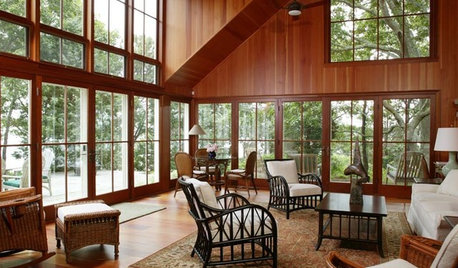Best Way to Seal Rubble Foundation Against Water and Radon?
Hi, I am new here, hoping someone can help. We have a 200 year old house with a rubble foundation. It is structurally sound, but there are lots of gaps, cracks, and small loose stones that allow water in during heavy rain. That's fine, but we've recently learned we have a radon problem that cannot be fixed until the foundation is sealed. What would be the most efficient and reliable way to do this? Repointing would be very expensive and we'd still need to coat the stone faces with sealant. Could we apply Shotcrete, gunite, or closed cell spray foam directly to the un-mortared walls? (We will repoint the exterior and work on better drainage to keep water away.) Thanks for any insight!
Comments (22)
akamainegrower
10 years agolast modified: 9 years agoWith the proper equipment, shotcrete or gunite can be sprayed on the walls over wire mesh for additional strength. This requires specialized equipment and a knowledgable operator so is definitely not a DIY project. Whether this is sufficient sealing for radon mitigation, I don't know. The cost when I had it done several years ago was very reasonable - around 1500.
A couple of cautions:
1)This is not a neat process. The gunite will stick to any unprotected surface. The walls, unless they are troweled - which would add greatly to the cost, - will be rough.
2) Rubble walls were usually designed to allow water through which was then directed to a cellar drain in order to exit. You need to be very careful that you do not create a situation where water builds up on the exterior side of the walls. Hydrostatic pressure and freezing can cause serious damage to the walls, footings, etc.Closed cell foam may work, but would not as far as I know add any strength to the walls as the concrete products do. The sprayed gunite can also be used on the dirt floor area.
newenglandgarden
Original Author10 years agolast modified: 9 years agoThanks! We definitely would not be DIYing this. Getting estimates next week. Appreciate your response - the old-fashioned mortar approach would definitely look more charming, but a damp, radon-filled basement is not a place I want to hang out anyway.
liriodendron
10 years agolast modified: 9 years agoI'm not sure you can fix a radon problem by attempting to seal the sides of the foundation and the floor.
Radon is best vented up and out, which will be a more reliable removal than trying to block it from coming in, which I think you could never do in an old house.
Sealing up a rubble foundation may bring on additional problems as they were designed to be unsealed (in the modern sense) and by nature somewhat leaky and flexible. By sealing it you are applying modern technology to the tried and true 19th c system that has permited the building to stand for two centuries, so far.
Curing a damp, dirt basement floor is not done with just pea gravel and concrete. You need to install a moisture retardant film (not just construction poly) under the the walking surface. To be completely effective it has to be sealed against the joint where the floor meets the rubble wall. This is difficult to do perfectly - if not impossible -and since vapor is always rising you may just re-channel it to the foot of the wall. There have been reported issues arising from so effectively blocking the never-ending rising soil moisture (i.e. not from leaks from poor surface drainage, which is a different problem) from being dispersed into the cavity of the basement that it begins to super saturate the soil just outside the foundation causing structural issues there. This is probably more of an issue with not very deep foundations typically found around crawl spaces rather than full basements. The "rubble" rocks of a full basement are actually enormous, you just can't see most of their bulk which extends into the surrounding soil outside.
In short you are up aganst one the constant dilemmas of old house ownership: how to marry what we (currently) believe about buildiing technology with a system that was designed around other beliefs about what works.
Faced with your issues I would do these things, in this order:
1) If the radon level is high enough to warrant it, install some type of radon remediation ventilation system, fans, piping to outdoors etc. If you ever went to sell the house you would need to do this before most people would buy it anyhow, so you might as well have the benefit of it while you are living there. Trying to block radon from entering is a fool's task as it can never be completely blocked, only vented to the outside. (I would also have the radon testing done by an independent lab, not by a company that also sells remediation. There are too many scams around radon to be confident if the tester is also the proposed fixer.)
2) Address surface drainage issues (these change over time and must be attended to whenever they crop up.);.
3) Repoint the interior surface of the rubble wall (that's just normal maintenance). In an old house you must use special mortars (i.e. not Portland Cement) for the repointing.
- Coat (paint) it with traditional lime-based whitewash which not only lightens the room up but also retards fungal growth on the damp cool stone surfaces and matches the pH of most lime mortars. Paint will not stick to rubble walls. Whitewash will need to be reapplied from time to time, but it presents no other issues.
5) Consider the temporary (but longish term) and completely reversible solution of installing vapor retardant film over the concrete of the floor and under the pea gravel in the cistern. Cover the vapor retardant film with loosely laid vinyl flooring to protect it from damage as you walk on it. This will drastically cut down on the amount of vapor entering the basement, without completely obstructing it - and without running the risk that it goes elsewhere and creates a more serious problem.
6) Put some study into various basement ventilation systems to move damp, cool air out of the basement during most of the year (assuming you are in a cool/cold climate). Vapor rises up in response to wind speed and outside air pressure - two factors that you can never hope to control. But a good system will be able to work with these factors, not against them.
7) Consider at some later time harnessing some of the cool dampness of your celler to use as a root cellar. It's what it was designed for and some day perhaps food storage w/o refrigeration will once again be a good idea. At the very least don't put money into forgoing that possibility forever.
Now, only the radon system probably requires paying someone else to do the work (and certify the results, which you would need for your own peace of mind and certainly for resale).
The rest can you do yourselves, teaching yourself what you need to know as you go.
And pay attention to the essential point raised by this area: old houses are NOT just antique versions of modern buildings. They are complete building systems, which can be profoundly - and sometimes not for the better - altered if we try to remodel them into modern buildings. You are never going to have a dry basement of the kind you'd have in a house with an insulated, vapor-blocked poured concrete foundation. You will always have a rubble-walled basement, not a bonus faimly room to hang out in. (Well, I suppose you could jack the house up, call in heavy machinery, dig a huge hole, pry out the stones of the wall, set forms, rebar, pour a footing and foundation, water seal it on the outside, insulate it, close the hole, grade it, put in an interior vapor plane, footing drains, pour a floor, install studs and dry wall, etc., then lower the house back down and write many huge checks to pay for this. I think that's the way they do it on This Old House, alas.)
I live in a pre- Civil War house with a rubble foundation and a (mostly) dirt floor. These are issue I've been grappling with for a quarter of a century.
Now, in fairness I know there is at least one guy who thinks this approach is all nonsense. He's a self-styled building technology engineer and has a big presence on the web. He has, for his own house in eastern MA, taken another approach: He had the entire interior of his rubble-walled cellar sprayed with insulating foam, effectively entombing it, permanently. Perhaps that technique will be shown to be effective and benign for the building. We won't know for many decades, however. But it isn't reversible if it turns to be bad for the building. (And as even he notes, he has created a secondary flammability/fire safety problem because properly the foam needs to be covered with a fire-safe wall material, which when I last checked out his website, it was not.)
You building is under your care, you can go which ever way you think is best. But don't ever imagine you can just add-on modern standards and building methods without risking dismantling some essential piece of the old system. Go slow, think reversible, and remember these old buildings are old precisely because they are survivors. Other building technologies failed and those buildings no longer exist.
L
newenglandgarden
Original Author10 years agolast modified: 9 years agoHi, thanks. The problem is that we cannot tackle the radon issue without first sealing the walls and covering the dirt patches - if we install a mitigation system without doing that first, it will only pull in more radon. We tried to get around that by installing an HRV, but it has not lowered the levels enough. Repointing would cost $10k, and we would still need to put some kind of sealant over that, so it just isn't cost-effective.
liriodendron
10 years agolast modified: 9 years agoWell, if an HRV has already failed, then you're looking at subslab depressurization systems, I think.
In an old house without modern-type gravel under whatever concrete floor may have been poured since it was built, I think that would mean that you'd remove the existing floor, lay gravel down installing collection pipes through it, then install some sort of sealed concrerte slab above for a walking surface and to contain the radon until it percolates over to the collection pipes and thence up and out of your house. This may raise your cellar floor enough to create problems with room height (or not, my own cellar is nearly 9.5 feet tall, so I could afford to lose some space to a new slab).
If an HRV has failed, I am very dubious of any sealant being applied that would effectively block gaseous transfer.. Apparently you have a very serious radon-production problem,
Perhaps you should consider installing some kind of interior block wall inside the rubble walls, perhaps combined with some kind of pressurization/piping system within the space behind the block walls to collect any radon that entered from the rubble area and venting. I think this would only work in combination with some kind of sub floor collection system. The upside is that yoou would wind up with a much dryer, almost modern-construction kind of basement, and one w/o radon.
In any event if the problem is this serious I would resign myself to the considerable expense of a professionally installed and warranteed system. (Warranty that it works to get the levels down to safety, or you don't pay.) You will have to address this on resale, so might as well bite the the bullet and do it as soon as possible.
Just be wary of people with proprietary, quick-fix systems, that won't guarantee successful, documented by third-party, results. You have probably already been to the EPA radon website, right?
Good luck, I hope you can make some inroads.
L.
southerncanuck
10 years agolast modified: 9 years agoNot much to add here but I do want to commend liriodendron on giving fantastic information here. Great posts, you just received a few thousands worth of consulting fees for nothing.
I know the value of keeping the wall aesthetically original is great. However knowing what we know now in building science I would suggest replacing the entire foundation wall as well as pouring new footings and floor and bringing it up to modern specs and forgetting about it for another 100 years.
newenglandgarden
Original Author10 years agolast modified: 9 years agoThanks so much for taking the time to reply. The radon mitigation people would warranty their work (to below 4) but they said we have to get the walls and some holes and areas of bare dirt in the floor filled in first. They thought that alone would make some difference. They are talking about putting big pipes in the floor in each room that would suck out the bad air. We don't care at all about the aesthetics at this point (it is a dirty rabbit warren filled with poison air :), we just want to do this in the most efficient and cost-effective way possible and ASAP since we have little kids. It sounds like people are recommending replacing the entire foundation which would be a huge and very expensive job - could this really be necessary? Our radon level is currently 5 on the main level, higher than I'd like but surely there must be some way to get it down other than totally rebuilding the whole house? Now I'm really panicked, that would be a HUGE job.
liriodendron
10 years agolast modified: 9 years agoWhile I know you are very worried, I think radon takes some cumulative exposure, over years, to be damaging. So I think you can afford to take a bit of time to make sure you're on the right track. Have you already lived at the house awhile?
Still, if you have a problem you do need to get it fixed, because as it stands it sounds as though you would have a hard time reselling the house without doing so.
I wasn't suggesting you dig up and replace your whole foundation. I'm sure that would be extremely expensive.
Does the company that proposes to install the depressurization system do the foundation sealing as well? If not, I think issues may arise after you've paid for the foundation sealing work, etc., and the radon system. If that doesn't do the trick the radon people might claim that it's not their fault, because the sealing job was defective, or not thorough, or not long-lasting enough (which would be where I would expect it to fail).
Can you get one company to do all the work, and stand behind the fix? Otherwise I think you are possibly looking at an ongoing financial drain (one that won't drain away the da*m radon, just your savings account.)
Although I am dubious about the permanence and reliability of sealing up the rubble foundation wall in a cold area with deep frost penetration (I am assuming from your user name that you don't live in Florida!) against radon infiltration, perhaps it's the best known technology. But I'd want to know, before agreeing to it, that it really does work.
One of my concerns is this: rubble walls (unlike modern block or concrete walls) are by their nature intended to be able to withstand some ground movement and repetitive soil water infiltration pressure. (That's one of the reasons these old houses are still standing, sometimes for two centuries or more.) Over time small openings that ocurr because of this tend to appear. But they are quite likely to close and then reopen in another place in other years. Pointing only fixes the visible cavities at the time it is done. It's not a gas-blocking technique. At best it can keep out major seeps, bugs, snakes and the occasional misguided mole. I can't imagine any rigid coating (like sprayed-on gunnite) being to handle this built-in expectation of movement without cracking. And I doubt you could get any flexible coating to stick effectively enough to stay stuck on and prevent gas entering.
But, what do I know? I've only dealt with my own foundation to prevent the seeps, bugs and moles from coming in (snakes are welcome to hibernate in my cellar), and to stick on the odd frost-cracked-off corners.
It sounds like whatever you need to do do may be a painfully expensive project. Have you considered trying to get engineering guidance from a geologist or civil engineer?
Do you live in an area with a big radon issue? Are there lots of remediation companies? I'd sure be seeking a lot of quotes.
Is there a state agency that can help give you some locally relevant advice about what really works? You are surely not the only people living in an old house that have faced this same constellation of problems.
I do wish you good luck, and if you find the solution, I hope you will return and describe it in order to add to our collective store of information.
Liriodendron
akamainegrower
10 years agolast modified: 9 years agoAn experienced gunite/shotcrete operator leaves enough area toward the bottom of the wall to allow for some seepage of moisture. This is then directed toward the cellar drain by whatever system - a gutter around the periphery, for example - the original foundation builders created. 17 years after it was done, I have not found any cracks at all in the shotcrete coating on my own rubble foundation which dates from roughly 1860.
newenglandgarden
Original Author10 years agolast modified: 9 years agoThank you akamainegrower - that is really good to hear.
newenglandgarden
Original Author10 years agolast modified: 9 years agoliriodendron, thanks so much for your thoughtful reply. We have been living here for several years and since we have young kids I am definitely worried. I do indeed live in New England and radon is a huge issue here.
Reading over my post, I'm realizing I wasn't clear, probably because I can barely keep it straight in my own mind!
We wouldn't be sealing the foundation walls to keep radon out per se, but rather to allow the HRV and mitigation system (once installed) to do their jobs. Right now our basement is basically wide open, so if we installed a mitigation system to suck out contaminated air, it would pull as much from outside as from indoors. That would be fine if it were sucking in clean air from outside, but because the room is below ground-level it would likely bring in MORE radon. This is why people tell us sealing the walls may be enough in and of itself, because the hrv wil work better.
We should get the walls sealed anyway, to keep out the water, chipmunks and occasional vine.
So my question should really have been: what is the best way to seal rubble walls for the long term, when aesthetics are not an issue? Thanks again for any advice ...
edlincoln
10 years agolast modified: 9 years agoAt the risk of being naive, why can't you insulate the basement roof/bottom floor and install an airtight vapor barrier? That way radon won't leak from the basement into the house.
OK, you would have radon in your basement still, but how often do you go down there anyway?
Or what about creating "chimney" like vents that suck outside air into the basement? I know they do that in tunnels.
1884farmhouse
9 years agoI'd like to know where you ended up with this. I live in RI and have the same problem. Bought and old house years ago, now have kids, and of course now radon is testing high.
First thing I did was buy a radon monitor. It's called the "Corentium Digital Radon Gas Monitor". You can buy it online for $245. I've had mine for 6 weeks and has told me a lot about the radon levels in my house. Craziest thing is that radon levels fluctuate day to day and can vary a couple of points so the 2-day tests are in my view, worthless. Also radon levels vary seasonally. The best radon test is an average over a year, with a minimum reading of a week. What's great about a continuous monitor is that you can tell hourly if the radon levels drop because of your mitigation. FYI opening windows does work for about a day then they go right back up again; great for summer, chilly in winter.
My basement is mostly old poured concrete (more like a rat slab) and I have some open dirt sections. My plan this summer is to take up the old slab and install a proper radon pipe grid, cover with gravel, then poly, then top with new concrete. That should give me a better, drier, basement and also eliminate radon from the slab. I'll pipe it for a passive system and if it doesn't work I'll add the fan. It's unlikely that you or I have a decent layer of gravel under the old basement slab so any point suction mitigation won't work. that works in newer foundations that have the gravel but not the piping.
The second thing is a perimeter drain. This will relieve the pressure against the outside wall and vent the water and radon gas to daylight. Radon gets sucked through the rubble walls by stack-effect so I plan to put a layer of poly against the foundation to act as a vapor barrier, then a perimeter drain product by Eljen.
Good luck, we'll both need it.
southerncanuck
9 years agoThis thread is a year old bit I too would like to know what they eventually did and how it effected Radon penetration if at all. I haven't been on this site much this past year. I don't remember if one can PM, personal message, a fellow member. I have received emails from members here. I will try to message the original poster for an update. A note to newer members and those that have been here for some time. Asking a question and getting good advice is great. Members like those above like liriodendron have taken time to help by giving advise and making suggestions. It is only fitting that an OP update here with results based on that advice, that is one way we can all learn what works and what doesn't.
southerncanuck
9 years agoI don't see a profile for members like they had on Gardenweb. Am I missing something?
worthy
9 years agolast modified: 9 years agoJust wanted to point out that the "self-styled building technology engineer [with a] big presence on the web." condemned by the anonymous poster "liriodendron" is likely Dr. Joseph Lstiburek, Phd., P. Eng. ASHRAE Fellow, a major consultant to the US Department of Energy EERE (Office of Energy Efficiency and Renewable Energy) programs, etc., etc.
As for the specific point that the foam insulated rubble foundation in Lstiburek's piece was not fire-protected, the report shows it being coated with a liquid-applied ignition barrier. According to Dr. Lstiburek, the system has been effectively used many times over the past 20 years.
southerncanuck
9 years agoWell if it is the esteemed Doctor who of which I have had the pleasure of reading much of his work on Building Science for many years I'm honoured to be on the same thread as he.
What is it that brings you to that conclusion Worthy. And please jog my memory. Was it you a few years back that remodeled the old workers cottage?
renovator8
9 years agolast modified: 9 years agoMy name can be added to liriodendron's list of those who think his ideas about foundations are nonsense along with Dr Lstiburek. I confess I couldn't get though a lot of the other stuff. All foundations serve the same simple structural purpose. I too have sealed a rubble wall with closed cell plastic foam and protected it with an intumescent coating. Dr Lstiburek's greatest trait is that he continues to study building envelopes, offer advice for free and corrects himself when he finds contrary evidence. To use his information properly it is necessary to take the time to stay abreast of his work. I have used his consulting services for difficult project conditions and exchanged emails with him about difficult topics online for no charge. I have no idea who liriodendron is but I would be very cautious about taking his advice.
Skip1909
8 years agoI have to bump this thread since people are mentioning Dr Lstiburek and seem familiar with his approach. I have read his article on rubble foundations several times but still have questions. Here is the article: http://www.buildingscience.com/documents/insights/bsi-041-rubble-foundations
The part where he jacks up the house a little and installs a capillary break seems to be a really important part of his approach. Is this something a good water proofing company will be familiar with? Is jacking still possible if the house has 2 brick chimneys passing through floors, interior walls, and perimeter walls? He says he and other folks have done this process a "gazillion" times, but I have a feeling if I call a waterproofing company over for an estimate, thats not the approach they'll recommend. If i was to only contract out the jacking job, it seems like it would be very expensive, is this more common than I think?
Also, does he have a perimeter drainage zone around the shallow part of the crawl space with a channel or something leading down to the deeper basement part, or is the drainage zone only in the deeper part?He also knocks out a demising wall and replaces it with a column, but for a normal homeowner, wouldn't a structural engineer be needed to plan that process?
lazy_gardens
8 years agoSkip - nothing about jacking up houses and replacing walls with columns is easy or cheap.
But it's cheaper than having to demolish whole house and rebuild, and way easier on your body than having the rubble collapse on you and bring the house down unexpectedly.Vith
8 years agoConsidering you are supposed to seal the basement for radon management and you cannot do that with your current foundation, I personally would have them do a vertical grid of weeping drain for the exterior walls and connect a radon fan to that. Then I would have a separate radon fan for subslab suction. I feel this would be a complete solution managing radon from the walls and from the floor without sealing the walls.




















1884farmhouse